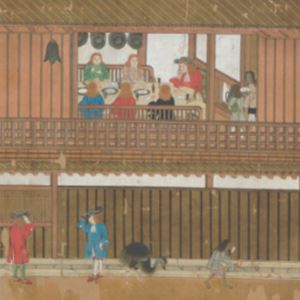
Life of the Dutch at the Deijima trading post
This Japanese painting on silk gives us a glimpse of the Deijima trading post, located in Nagasaki Bay. On this minuscule island – no bigger than Dam Square in Amsterdam – the East India Company operated for 150 years as the sole foreign venture permitted to trade with Japan. Dutch ships were allowed to moor there once a year. The Japanese were only allowed onto the island in exceptional cases, and in turn the Dutch were only allowed to leave under very specific circumstances. For the Japanese, Deijima was their window onto the western world. It is clear that this painting shows the Dutch post outside of trading season, as what we see are largely leisure activities. That seems to be a deliberate choice by the artist, as it was here that the Dutch culture differed so markedly from the Japanese. In the foreground on the left, for instance, a form of badminton is being played. In the central room at the top, a cello, harp and violin make up a classical European ensemble. In the middle in the foreground, we can see two Dutchmen greeting each other by raising their hats. The Dutch are represented uniformly with white faces, long reddish hair and large hook noses – in fact just as stereotypically as Europeans from that time depicted people from Africa and Asia. The dark-skinned people in the painting are the Javanese servants of the Dutch.


The National Maritime Museum
Het Scheepvaartmuseum (The National Maritime Museum) shows the strong connection between the maritime world and society as a whole, and more specifically the impact of this on the lives of many individuals. The collection of The National Maritime Museum is one of the largest and most notable maritime collections in the world with approximately 400,000 objects, including paintings, models of ships, navigation instruments, and maps of the world. Discover 500 years of Dutch Maritime history as well as its strong links to today’s society and the society of the future.
- Kattenburgerplein 1
- Amsterdam Netherlands
- (020) 52 32 222
- www.hetscheepvaartmuseum.nl
